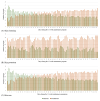User Experience of and Adherence to a Smartphone App to Maintain Behavior Change and Self-Management in Patients With Work-Related Skin Diseases: Multistep, Single-Arm Feasibility Study
- PMID: 40249942
- PMCID: PMC12048786
- DOI: 10.2196/66791
User Experience of and Adherence to a Smartphone App to Maintain Behavior Change and Self-Management in Patients With Work-Related Skin Diseases: Multistep, Single-Arm Feasibility Study
Abstract
Background: Smartphone apps are a growing field supporting the prevention of chronic diseases. The user experience (UX) is an important predictor of app use and should be considered in mobile health research. Long-term skin protection behavior is important for those with work-related skin diseases. However, altering health behavior is complex and requires a high level of self-management. We developed a maintenance program consisting of the Mein Hautschutz im Alltag (MiA; "My skin protection in everyday life") app combined with an individual face-to-face goal-setting interview to support patients in the implementation of skin protection behavior after inpatient rehabilitation.
Objective: The objectives of this paper are to (1) describe the intervention in a standardized manner; (2) evaluate the UX, subjective quality, and perceived impact of the MiA app; and (3) evaluate the adherence to the MiA app.
Methods: We followed a user-centered and multistage iterative process in 2 steps that combined qualitative and quantitative data. The maintenance program was tested over 12 weeks after discharge from rehabilitation. The UX, subjective quality, and perceived impact were evaluated formatively based on the user version of the Mobile Application Rating Scale after 12 weeks (T2). Adherence was measured using the frequency of interactions with the app.
Results: In total, 42 patients took part (with a dropout rate of n=18, 43% at T2). The average age was 49.5 (SD 13.1) years, and 57% (24/42) were male. We found high ratings for the UX, with an average score of 80.18 (SD 8.94) out of a theoretical maximum of 100, but there were a few exceptions in the usability and interaction with the app. The app was most frequently rated with 4 out of 5 stars (15/24, 65%), which indicates a high subjective quality. Furthermore, the app seemed to influence important determinants to implement skin protection behavior. Adherence to skin protection tracking was higher over the study period than adherence to skin documentation and goal assessment. The number of adherent participants to skin protection tracking was higher in the skin care and skin cleansing categories (28/42, 67% each) compared to the skin protection category (13/42, 31%) on day 1 and decreased until day 84 in all dimensions (12/42, 29% each for skin care and skin cleansing; 9/42, 21% for skin protection).
Conclusions: The results in terms of adherence met the expectations and were consistent with those of other studies evaluating the use of apps for chronic diseases. Interaction with the app could be increased using artificial intelligence to determine eczema severity via photos. It should be investigated which subgroups have difficulties with usability to individualize the support to a greater degree during onboarding. There is a need for further research regarding the effectiveness of the MiA app on skin protection behavior, quality of life, and eczema severity.
Keywords: Template for Intervention Description and Replication; app; artificial intelligence; behavior change; behavior change techniques; complex intervention; mHealth; mobile health; occupational dermatology; skin diseases; smartphone; user experience.
©Nele Ristow, Annika Wilke, Christoph Skudlik, Swen Malte John, Michaela Ludewig. Originally published in JMIR Formative Research (https://formative.jmir.org), 18.04.2025.
Conflict of interest statement
Conflicts of Interest: None declared.
Figures








Similar articles
-
An approach to boost adherence to self-data reporting in mHealth applications for users without specific health conditions.BMC Med Inform Decis Mak. 2025 Jan 10;25(1):16. doi: 10.1186/s12911-024-02833-4. BMC Med Inform Decis Mak. 2025. PMID: 39794737 Free PMC article.
-
Mobile Health App for Adolescent Asthma Self-Management: Development and Usability Study of the Pulmonary Education and Knowledge Mobile Asthma Action Plan.JMIR Form Res. 2025 Apr 24;9:e64212. doi: 10.2196/64212. JMIR Form Res. 2025. PMID: 40272455 Free PMC article.
-
Evaluating User Experience and Satisfaction in a Concussion Rehabilitation App: Usability Study.JMIR Form Res. 2025 Apr 11;9:e67275. doi: 10.2196/67275. JMIR Form Res. 2025. PMID: 40215401 Free PMC article.
-
Perceptions of Smartphone User-Centered Mobile Health Tracking Apps Across Various Chronic Illness Populations: An Integrative Review.J Nurs Scholarsh. 2017 Jul;49(4):371-378. doi: 10.1111/jnu.12298. Epub 2017 Jun 12. J Nurs Scholarsh. 2017. PMID: 28605151 Review.
-
A Patient-Oriented App (ThessHF) to Improve Self-Care Quality in Heart Failure: From Evidence-Based Design to Pilot Study.JMIR Mhealth Uhealth. 2021 Apr 13;9(4):e24271. doi: 10.2196/24271. JMIR Mhealth Uhealth. 2021. PMID: 33847599 Free PMC article.
References
-
- Milne-Ives M, Lam C, De Cock C, Van Velthoven MH, Meinert E. Mobile apps for health behavior change in physical activity, diet, drug and alcohol use, and mental health: systematic review. JMIR Mhealth Uhealth. 2020 Mar 18;8(3):e17046. doi: 10.2196/17046. https://mhealth.jmir.org/2020/3/e17046/ v8i3e17046 - DOI - PMC - PubMed
-
- Meyerowitz-Katz G, Ravi S, Arnolda L, Feng X, Maberly G, Astell-Burt T. Rates of attrition and dropout in app-based interventions for chronic disease: systematic review and meta-analysis. J Med Internet Res. 2020 Sep 29;22(9):e20283. doi: 10.2196/20283. https://www.jmir.org/2020/9/e20283/ v22i9e20283 - DOI - PMC - PubMed
-
- Kitazawa M, Takeda Y, Hatta M, Horikawa C, Sato T, Osawa T, Ishizawa M, Suzuki H, Matsubayashi Y, Fujihara K, Yamada T, Sone H. Lifestyle intervention with smartphone app and isCGM for people at high risk of type 2 diabetes: randomized trial. J Clin Endocrinol Metab. 2024 Mar 15;109(4):1060–70. doi: 10.1210/clinem/dgad639. https://europepmc.org/abstract/MED/37931069 7335884 - DOI - PMC - PubMed
-
- Stawarz K, Cox AL, Blandford A. Beyond self-tracking and reminders: designing smartphone apps that support habit formation. Proceedings of the 33rd Annual ACM Conference on Human Factors in Computing Systems; CHI '15; April 18-23, 2015; Seoul, Republic of Korea. 2015. - DOI
MeSH terms
LinkOut - more resources
Full Text Sources
Medical
Miscellaneous

